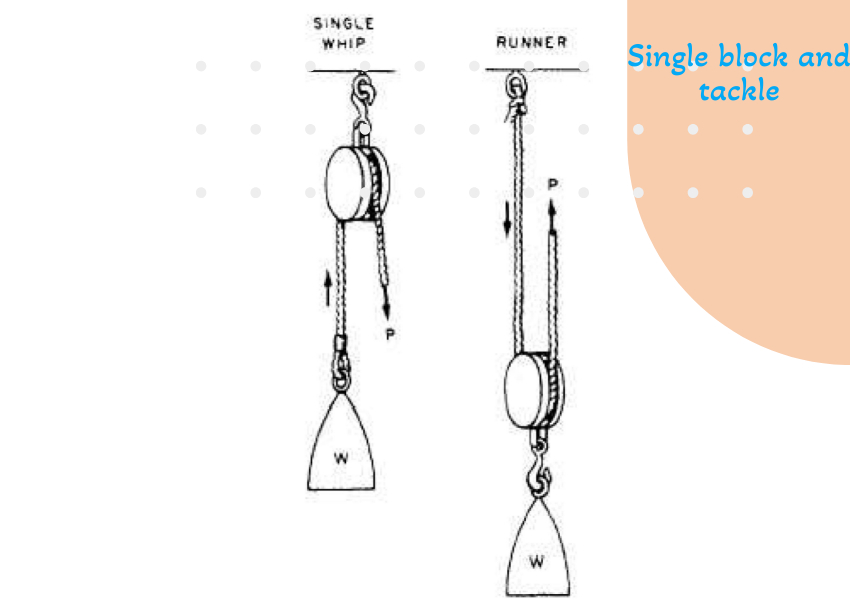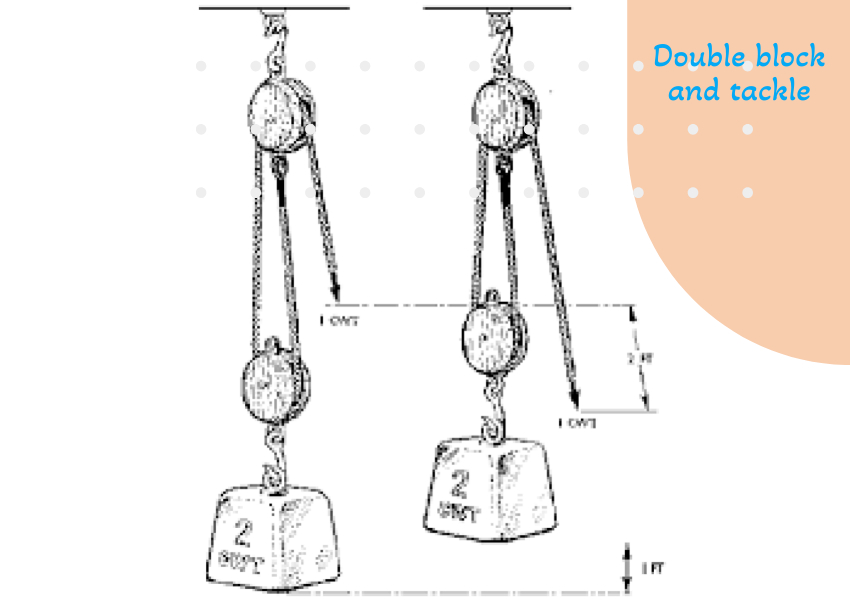Block and tackles are simple machines that use pulleys to amplify force and lift heavy objects. They are made up of two or more pulleys and a rope. The rope is threaded through the pulleys in such a way that it creates a mechanical advantage, allowing you to lift heavier objects with less effort.
There are many different types of block and tackles, each with its advantages and disadvantages. The type of block and tackle you choose will depend on the specific application you need it for.
Single block and tackle

The single block and tackle is the simplest type of block and tackle. It consists of two pulleys and a rope. The rope is threaded through the two pulleys and attached to the object you want to lift at one end. The other end of the rope is attached to a fixed object.
Single block and tackles provide a mechanical advantage of 2:1, meaning you can lift twice as much weight as possible without using a block and tackle. However, they are not as powerful as other types of block and tackles.
Double block and tackle

The double block and tackle is more powerful than the single block and tackle. It consists of four pulleys and a rope. The rope is threaded through the four pulleys in such a way that it creates a mechanical advantage of 4:1, meaning that you can lift four times as much weight as you can without using a block and tackle.
Double block and tackles are often used in construction and other applications where heavy objects need to be lifted.
Triple block and tackle

The triple block and tackle is even more powerful than the double block and tackle. It consists of six pulleys and a rope. The rope is threaded through the six pulleys in such a way that it creates a mechanical advantage of 6:1, meaning that you can lift six times as much weight as you can without using a block and tackle.
Triple block and tackles are used in applications where heavy objects, such as shipbuilding and machinery manufacturing, need to be lifted.
Other types of block and tackles
There are many other types of block and tackles available, including:
- Gun tackle: A gun tackle is a type of block and tackle that consists of two single blocks and a rope. It is used to lift heavy objects a short distance.
- Luff tackle: A luff tackle is a type of block and tackle that consists of two single blocks and a double block. It is used to lift heavy objects a long distance.
- Watch tackle: A watch tackle is a type of block and tackle that consists of two double blocks. It is used to lift very heavy objects.
Choosing the right block and tackle
When choosing a block and tackle, there are a few factors to keep in mind:
- Capacity: Make sure to choose a block and tackle with a capacity that is greater than the weight of the objects you will be lifting.
- Construction: Choose a block and tackle that is made with high-quality materials and features a durable construction.
- Accessories: Consider the accessories that are included with the block and tackle. Some block and tackles come with a carrying case, hooks, and a safety catch.
Also read: Best 1000 lb Block and Tackle
Applications for block and tackles
Block and tackles are used in a variety of applications, including:
- Construction: Block and tackles are often used in construction to lift heavy materials, such as lumber, drywall, and roofing shingles.
- Landscaping: Block and tackles can be used in landscaping to lift heavy objects, such as trees, rocks, and boulders.
- Automotive repair: Block and tackles can be used in automotive repair to lift heavy objects, such as engines, transmissions, and differentials.
- Marine industry: Block and tackles are often used in the marine industry to lift heavy objects, such as boats and anchors.
- Manufacturing: Block and tackles are used in manufacturing to lift heavy objects, such as machinery and equipment.
Safety tips for using block and tackles
Here are some safety tips for using block and tackles:
- Always inspect the block and tackle before using it to ensure it is in good condition.
- Do not overload the block and tackle. Ensure that the weight of the object you are lifting does not exceed the capacity of the block and tackle.
- Use caution when lifting heavy objects. Make sure you have a firm grip on the rope and are standing in a safe position.
- Be aware of your surroundings. Make sure that there are no obstacles in the way of the block and tackle or the object you are lifting.
FAQs
What is a block and tackle?
A block and tackle is a simple machine that uses pulleys to amplify force and lift heavy objects. It is made up of two or more pulleys and a rope. The rope is threaded through the pulleys in such a way that it creates a mechanical advantage, allowing you to lift heavier objects with less effort.
What are the different types of block and tackles?
The most common types of block and tackles are single block and tackles, double block and tackles, and triple block and tackles. Single block and tackles provide a mechanical advantage of 2:1, double block and tackles provide a mechanical advantage of 4:1, and triple block and tackles provide a mechanical advantage of 6:1.
What are the advantages of using a block and tackle?
Block and tackles offer some advantages, including:
They can be used to lift heavy objects with minimal effort.
They are relatively inexpensive and easy to use.
They are portable and can be used in a variety of locations.
What are the disadvantages of using a block and tackle?
Block and tackles also have some disadvantages, including:
They can be slow to use, especially when lifting heavy objects.
They can be dangerous if not used safely.
They require regular maintenance to ensure that they are in good condition.
How do I choose the right block and tackle for my needs?
When choosing a block and tackle, there are a few factors to consider:
The capacity of the block and tackle: Make sure to choose a block and tackle with a capacity that is greater than the weight of the objects you will be lifting.
The type of block and tackle: Choose the right type of block and tackle for the specific application you need it for. For example, you might choose a gun tackle if you need to lift heavy objects a short distance. You might choose a luff tackle if you need to lift heavy objects a long distance.
The construction of the block and tackle: Choose a block and tackle made with high-quality materials and durable construction.
How do I use a block and tackle safely?
Here are some safety tips for using a block and tackle:
Always inspect the block and tackle before using it to ensure it is in good condition.
Do not overload the block and tackle. Ensure that the weight of the object you are lifting does not exceed the capacity of the block and tackle.
Use caution when lifting heavy objects. Make sure you have a firm grip on the rope and are standing in a safe position.
Be aware of your surroundings. Make sure that there are no obstacles in the way of the block and tackle or the object you are lifting.
What are some common mistakes to avoid when using a block and tackle?
Some common mistakes to avoid when using a block and tackle include:
Overloading the block and tackle.
Not inspecting the block and tackle before using it.
Using a block and tackle that is not in good condition.
Using the wrong type of block and tackle for the specific application.
Not using caution when lifting heavy objects.
Where can I buy a block and tackle?
Block and tackles can be purchased at most hardware stores and online retailers.
Conclusion
Block and tackles are versatile and powerful tools that can be used in various applications. You can easily lift heavy objects with minimal effort by choosing the right type of block and tackle for your needs and using it safely.






